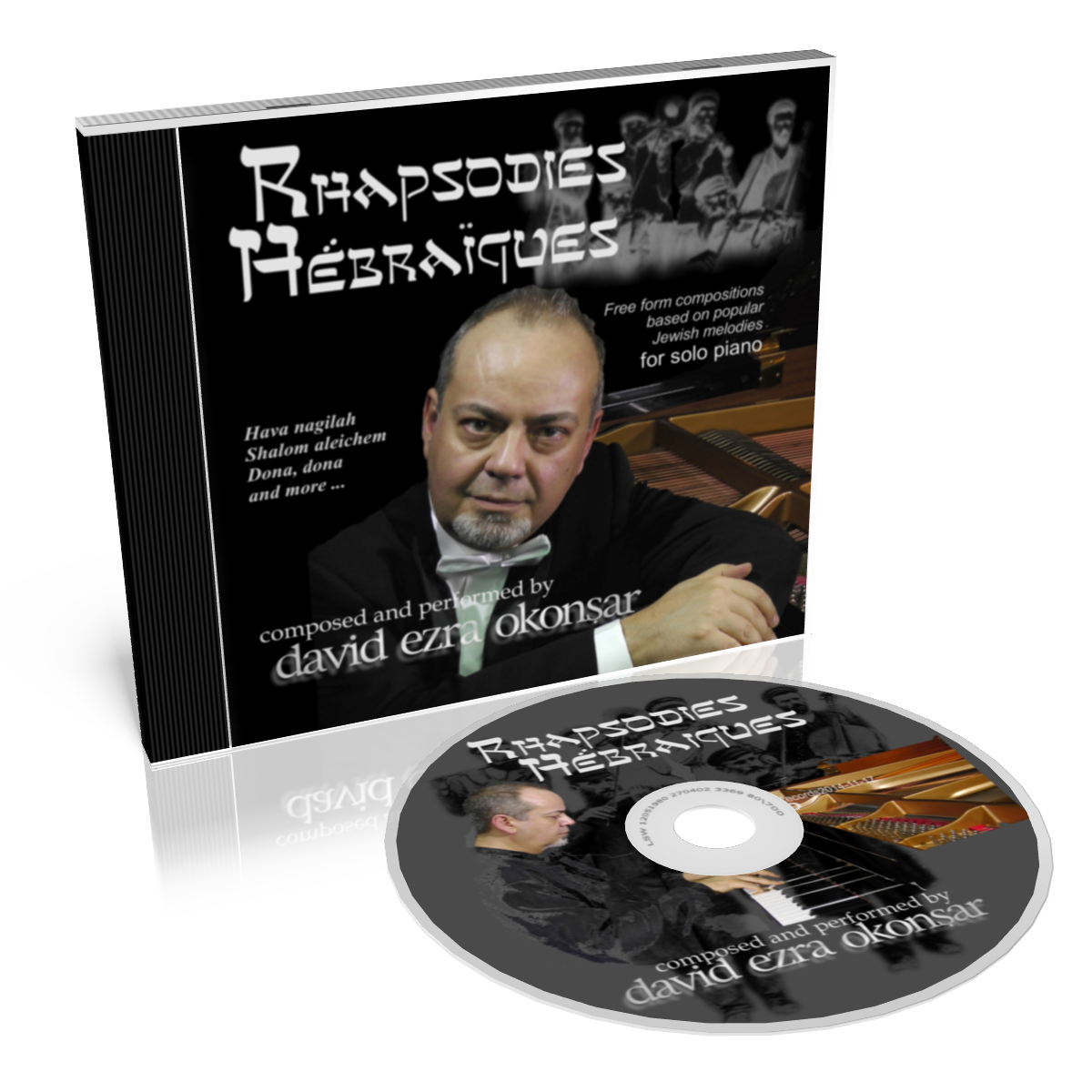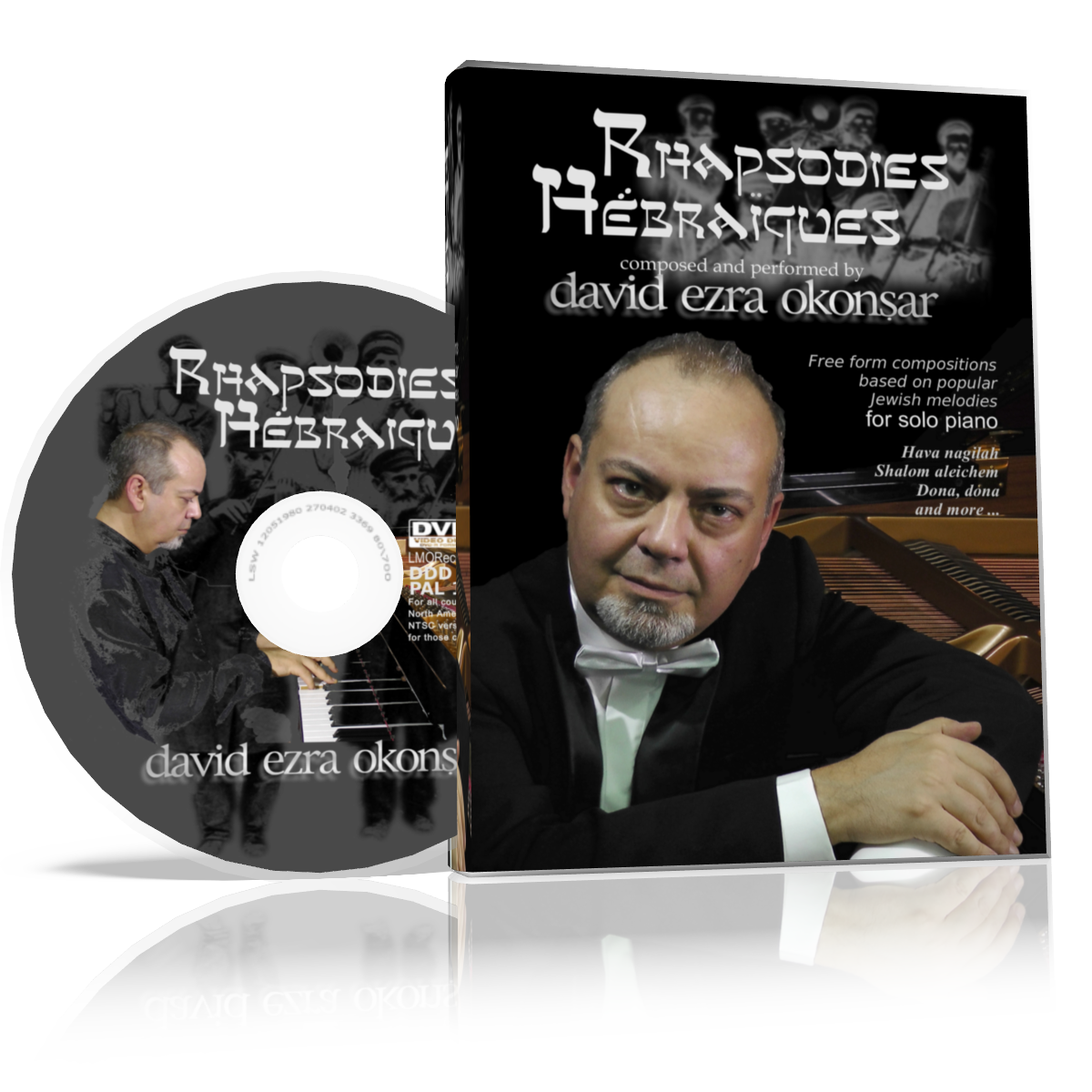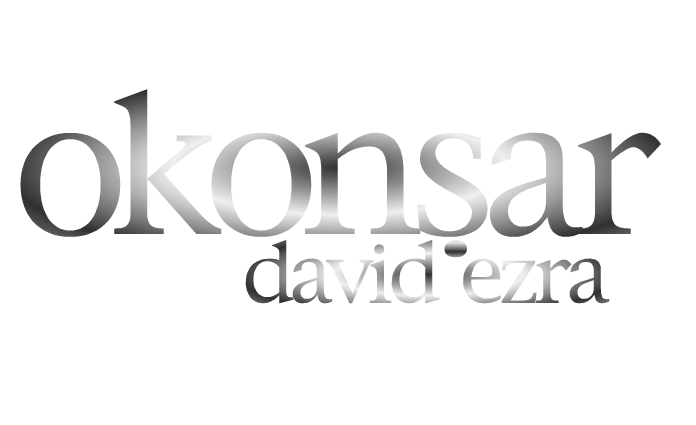
Rhapsodies Hébraïques
Free form compositions based on popular
Jewish melodies for the piano solo
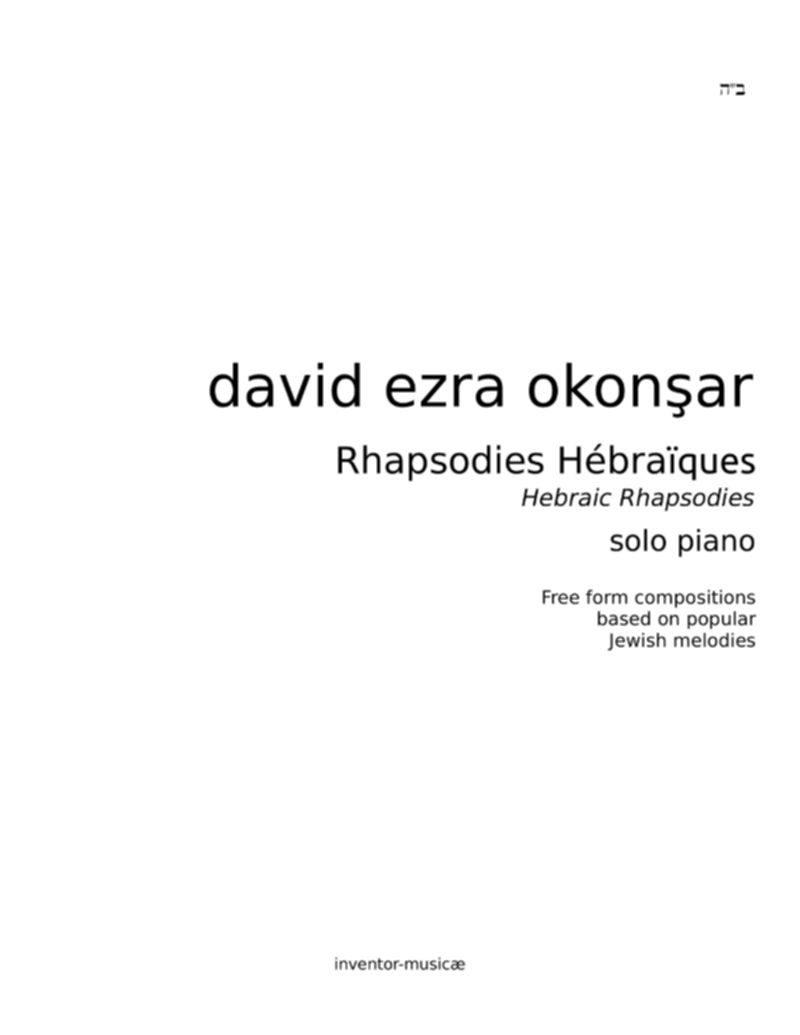
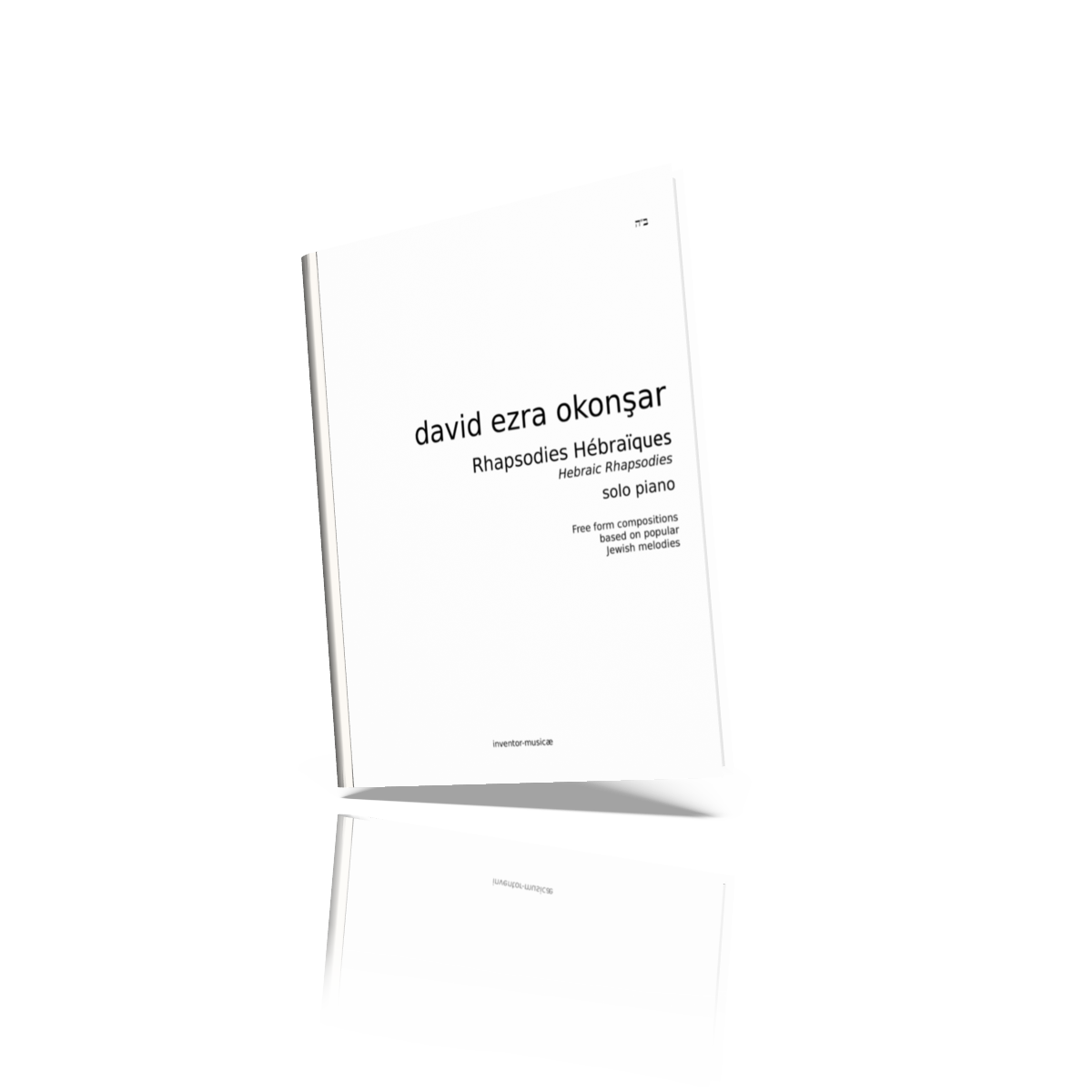
|
Rhapsodies Hébraïques
Fervent
Fervent researcher and aficionado of Jewish music and Klezmer, the
composer adopts here an expanded tonal language and models his
renditions of the traditional Jewish melodies on the Hungarian
Rhapsodies by Franz Liszt.
The themes featured in this series are laden with centuries of passion, love, hope and despair. They are the expression of most natural, sincere and authentic feelings. They move us directly and are able to speak to anyone at all times. Melancholy, sorrow, heartache coexist with bright cheerfulness and happiness in both minor and major modes. This selection of eight numbers among the vast Ashkenazi music repertoire includes a number of Klezmer tunes as well. In some pieces, for instance the "Hanukkah Medley" N.8 and "Purim" N.6, several related themes are combined and used together. In "Shalom Aleichem" N.2, both "Shalom Aleichem" melodies are used. Other Rhapsodies are variations and developments on one single tune except for "Hora Mamtera" N.3 where three Nigun's are used in the middle section. In both spirit and pianistic elaboration, even for the wording of the title, Hebraic Rhapsodies reflect on the Hungarian Rhapsodies by Franz Liszt. There is a resemblance, more in spirit than in actual notes, between Liszt's tunes borrowed from Roman folk culture and the Hebraic themes. Also the Hungarian musical scale and other scales found in Gypsy music are close to many Hebraic modes and scales. Is this music religious or profane? The boundaries are very blurred here. The religious feelings interact with the profane in the most true Jewish tradition. No hard and set distinction: in the joy of life we found the true expression of G-d. The first piece is "Hava Nagila" (Let us rejoice). This widely famous tune originates from a "hora-like" dance-song. All through it the Phrygian minor dominant scale is present, a very common aspect in music of Balkans. Lyrics are attributed to Abraham Zevi (Zvi) Idelsohn. Written around 1918 and celebrating the declaration of Balfour. Psalm 118 (verse 24) of the Hebrew Bible is considered the source of the lyrics: 24 This is the day which the LORD hath made; we will rejoice and be glad in it. Lyrics (in shortened form): Let's rejoice and be happy; Let's sing and be happy; Awake brothers with a happy heart. Next comes "Shalom Aleichem" (Peace be upon you). Shalom Aleichem is sung to welcome the angels who accompany a person from the Synagogue to home on the eve of the Sabbath. The Talmud teaches that two angels accompany a man on his way back home from the synagogue on Friday night: a good and an evil angel. If the house has been prepared for the Shabbat the good angel utters a blessing that the next Shabbat will be the same, and the evil angel is forced to respond "Amen". but if the home is not prepared for Shabbat, the evil angel expresses the wish that the next Shabbat will be the same, and the good angel is forced to respond "Amen". The liturgical text which makes the lyrics is attributed to Kabbalists of the late 16th century. Many different melodies have been written for Shalom Aleichem. The slow, well-known melody was composed by the American composer Samuel E. Goldfarb and his brother Rabbi Israel Goldfarb on 1918. This makes the central theme of the Rhapsody. While the beginning is based on Rabbi Shmuel Brazil's, originally much faster, melody. The lyrics in shortened form: Peace upon you, ministering angels, messengers of the Most High, of the Supreme King of Kings, the Holy One, blessed be He. Come in peace, messengers of peace [..] Bless me with peace [..] May your departure be in peace [..] Hora Mamtera & Nigunim: in this piece, Rhapsody number 3, Hora Mamtera is the main melody for a 4/4 time popular dance. A fast tune in the original form, I employed it very slowly as the beginning and ending parts of this Rhapsody. The theme's modal aspect, it uses a natural scale with no sensible tone and can be genuinely adapted to be used in a Pentatonic framework, suggested a kind of "impressionistic" realization. Many tremolos, fast and light arpeggios, ethereal textures are distinctive in the starting of the piece. I included as middle sections, two Nigun's ("nigunim"). Nigun means "melody" in Hebrew. They can be joyous or lamenting and mostly are wordless. Nigunim are essential in Hassidic Judaism. They can be sung on any syllabuses like "bim bam bam" or "ai ai aii". Although generally improvisatory many of them have well-known melodies. A Yiddish song composed by Moshe Nadir in 1927 is the base for this Rhapsody: "Der Rebbe Elimelekh". Lyrics narrate how the Rabbi Elimelech gets merry and merrier, takes off his glasses and Tefillin and sends after a fiddler, then a drummer, then for cymbals. The theme sounds very melancholic at the beginning but it evolves fast into an exuberant expression of the joy of life. An improvisatory introduction is followed by a recitative-like section which introduces the main melody. The famous tune is repeated in different settings and with an increasing excitement until the end. The lyrics summarized: So the Rabbi Elimelekh had become very happy [..] he took off the Tefillin and put on his glasses and sent after the two fiddlers. And the fiddling fiddlers had fiddled "fiddlingly" [..]. And then the Rabbi Elimelekh had become a bit more happy [..] and sent after the two drummers. And the drumming drummers had drummed "drummingly" [..]. And then the Rabbi Elimelekh had become totally happy [..] he took off the Kitl (suit) and put on a hat and sent after the two cymbalists. [..] The fiddling drummer had fiddled "cymballingly" and liquor-flowed himself with wine. The cheerful musicians with bottles under their arms caroused brightly till the next day. Rhapsody number 5 is "Donna Donna." This famous song is also known as "Dana Dana" or "Dos Kelbl" (The Calf). This is a Yiddish (the historical language of the Ashkenazi Jews which includes an extensive German based vocabulary.) theater song narrating the story of a calf being led to slaughter. Dana Dana was written for the stage production Esterke (1940) by Aaron Zeitlin with original music composed by Sholom Secunda. A "wonder child" hazzan (cantor) of Ukrainian-Jewish descent. Secunda was born in 1894 in Russia and died in New York in 1974. The composer published an English translated version of the song changing "dana" to "dona", however it failed to gain popularity. The lyrics were translated again in the mid 1950s by Arthur Kevess and Teddi Schwartz. Then the song became well known with those words. However became really popular after being recorded first by Joan Baez in 1960 then Donovan in 1965 and Patty Duke in 1968. Purim ("lots") from the word "pur" is a Jewish holiday that commemorates the deliverance of the Jewish people in the ancient Persian Empire where a plot had been formed to destroy them. The story is recorded in the Biblical Book of Esther. According to the Book of Esther, Haman, royal vizier to King Ahasuerus (presumed to be Xerxes I of Persia) planned to kill all the Jews in the empire, but his plans were foiled by Mordecai and his cousin and adopted daughter Esther who had risen to become Queen of Persia. The day of deliverance became a day of feasting and rejoicing. The basic material for the Rhapsody number 6 is two famous Purim songs combined, mixed and interwoven in various ways. Among many Purim songs two are specially famous: "Chag Purim" (Festival of Purim), the traditional children's Purim song par excellence and "Ani Purim" ("I am Purim"). Both of them are used in the Rhapsody. The minor key Chag Purim contrasts boldly with the major key Ani Purim. They are interlaced so as to bring abrupt switches of tone color. The seventieth Rhapsody is "Kal Nidre" (also known as Kol Nidrei). The opening prayer and the name for the evening service that begins Yom Kippur, the Day of Atonement. Its name is taken from the opening words, meaning "all vows". "All (personal) vows we are likely to make, all oaths and pledges we are likely to take between this Yom Kippur and the next Yom Kippur, we publicly renounce." This is to pray God to annul vows we may make (to Him) during the coming year, either innocently or under duress, that is vows made unintentionally through the careless use of words or vows made under pressure. Several musical renditions of the Kol Nidrei exists, the best-known of them are by the (non-Jewish) composer Max Bruch. The first part of the Rhapsody is structured with a choral ecriture. As with the Bruch's composition, a major section brings the climax. Hanukkah also spelled as Chanukah or Chanukkah, "The Festival of Lights"; "Feast of Dedication" is an eight-day Jewish holiday commemorating the re-dedication of the Second Temple in Jerusalem at the time of the Maccabean Revolt against the Seleucid Empire of the 2nd century BCE. A very large number of music have been created for Hanukkah. Maybe more than for any other holiday. The Rhapsody number 8 uses three main melodies in a medley fashion. First is the traditional music for the blessing on lighting the candle. It is followed by the famous: Maoz Tzur, both melodies are in major key. The blessing reads: "Blessed are You, Lord our God, King of the universe, Who sanctified us with His commandments and commanded us to kindle the Hanukkah lights." "My refuge, my rock of salvation! 'Tis pleasant to sing your praises. Let our house of prayer be restored. [..]" forms the central ideas and the beginning of Maoz Tzur. The third melody used in the Rhapsody is the, also infamous, "Oh Hanukkah" ("Oy Chanukah"). "Hanukah, Oh Hanukah, Come light the menorah, Let's have a party, We'll all dance the horah [..]". This a fast tempo minor key well-known melody. The piece makes use of all three tunes mixing and placing them in many different positions. |
|||
|
|||
|
|
|||
|
